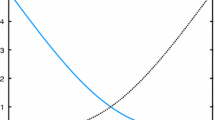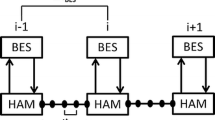Abstract
Implicit schemes require important sub-iterations when dealing with highly nonlinear problems such as the combined heat and moisture transfer through porous building elements. The computational cost rises significantly when the whole-building is simulated, especially when there is important coupling among the building elements themselves with neighbouring zones and with HVAC (heating ventilation and air conditioning) systems. On the other hand, the classical Euler explicit scheme is generally not used because its stability condition imposes very fine time discretisation. Hence, this paper explores the use of an improved explicit approach—the DuFort–Frankel scheme—to overcome the disadvantage of the classical explicit one and to bring benefits that cannot be obtained by implicit methods. The DuFort–Frankel approach is first compared to the classical Euler implicit and explicit schemes to compute the solution of nonlinear heat and moisture transfer through porous materials. Then, the analysis of the DuFort–Frankel unconditionally stable explicit scheme is extended to the coupled heat and moisture balances on the scale of a one- and a two-zone building models. The DuFort–Frankel scheme has the benefits of being unconditionally stable, second-order accurate in time O(Δt2) and to compute explicitly the solution at each time step, avoiding costly sub-iterations. This approach may reduce the computational cost by twenty as well as it may enable perfect synchronism for whole-building simulation and co-simulation.
Similar content being viewed by others
References
Barbosa RM, Mendes N (2008). Combined simulation of central HVAC systems with a whole-building hygrothermal model. Energy and Buildings, 40: 276–288.
Bauklimatik-Dresden (2011). Simulation program for the calculation of coupled heat, moisture, air, pollutant, and salt transport. Available at http://www.bauklimatik-dresden.de/delphin/index. php?aLa=en.
Berger J, Guernouti S, Woloszyn M, Chinesta F (2015). Proper generalised decomposition for heat and moisture multizone modelling. Energy and Buildings, 105: 334–351.
Berger J, Mazuroski W, Mendes N, Guernouti S, Woloszyn M (2016). 2D whole-building hygrothermal simulation analysis based on a PGD reduced order model. Energy and Buildings, 112: 49–61.
Burch D (1993). An analysis of moisture accumulation in walls subjected to hot and humid climates. ASHRAE Transactions, 99(2): 1013–1022.
Dos Santos GH, Mendes N (2004). Analysis of numerical methods and simulation time step effects on the prediction of building thermal performance. Applied Thermal Engineering, 24: 1129–1142.
Dos Santos GH, Mendes N (2006). Simultaneous heat and moisture transfer in soils combined with building simulation. Energy and Buildings, 38: 303–314.
Driscoll TA, Hale N, Trefethen LN (2014). Chebfun Guide. Oxford, UK: Pafnuty Publications.
Fraunhofer IBP (2005). Wufi. Available at http://www.hoki.ibp.fhg.de/wufi/wufi_frame_e.html.
Gasparin S, Berger J, Dutykh D, Mendes N (2017). Stable explicit schemes for simulation of nonlinear moisture transfer in porous materials. Journal of Building Performance Simulation, doi: 10.1080/ 19401493.2017.1298669.
Hagentoft C-E, Kalagasidis AS, Adl-Zarrabi B, Roels S, Carmeliet J, et al. (2004). Assessment method of numerical prediction models for combined heat, air and moisture transfer in building components: Benchmarks for one-dimensional cases. Journal of Thermal Envelope and Building Science, 27: 327–352.
Hensen J (1995). Modelling coupled heat and air flow: Ping-pong vs onions. In: Proceedings of Implementing the Results of Ventilation Research 16th AIVC Conference, Palm Springs, US, pp. 253–262.
Janssen H (2014). Simulation efficiency and accuracy of different moisture transfer potentials. Journal of Building Performance Simulation, 7: 379–389.
Janssen H, Blocken B, Carmeliet J (2007). Conservative modelling of the moisture and heat transfer in building components under atmospheric excitation. International Journal of Heat and Mass Transfer, 50: 1128–1140.
Kahan W, Palmer J (1979). On a proposed floating-point standard. ACM SIGNUM Newsletter, 14: 13–21.
Kalagasidis AS, Weitzmann P, Nielsen TR, Peuhkuri R, Hagentoft C-E, Rode C (2007). The international building physics toolbox in Simulink. Energy and Buildings, 39: 665–674.
Matlab (2014). The MathWorks Inc. Available at https://www. mathworks.com.
Mendes N (1997). Models for prediction of heat and moisture transfer through porous building elements. PhD Thesis, Federal University of Santa Catarina, Brazil. (in Portuguese)
Mendes N, Philippi PC (2005). A method for predicting heat and moisture transfer through multilayered walls based on temperature and moisture content gradients. International Journal of Heat and Mass Transfer, 48: 37–51.
Mendes N, Ridley I, Lamberts R, Philippi P, Budag K (1999), Umidus: A PC program for the prediction of heat and mass transfer in porous building elements. In: Proceedings of the 6th International IBPSA Building Simulation Conference, Kyoto, Japan, pp. 277–283.
Nayfeh A (2000). Perturbation Methods. Weinheim, Germany: Wiley VCH.
Richtmyer R, Morton KW (1967). Difference Methods for Initial-Value Problems. New York: Interscience Publishers.
Rode C, Grau K (2003). Whole building hygrothermal simulation model. ASHRAE Transactions, 109(1): 572–582.
Rouchier S, Woloszyn M, Foray G, Roux J-J (2013). Influence of concrete fracture on the rain infiltration and thermal performance of building facades. International Journal of Heat and Mass Transfer, 61: 340–352.
Steeman H-J, Van Belleghem M, Janssens A, De Paepe M (2009). Coupled simulation of heat and moisture transport in air and porous materials for the assessment of moisture related damage. Building and Environment, 44: 2176–2184.
Tariku F, Kumaran K, Fazio P (2010). Transient model for coupled heat, air and moisture transfer through multilayered porous media. International Journal of Heat and Mass Transfer, 53: 3035–3044.
Taylor PJ (1970). The stability of the Du Fort-Frankel method for the diffusion equation with boundary conditions involving space derivatives. The Computer Journal, 13: 92–97.
Van Genuchten M (1982). A comparison of numerical solutions of the one-dimensional unsaturated–saturated flow and transport equations. Advances in Water Resources, 5: 47–55.
Woloszyn M, Rode C (2008). Tools for performance simulation of heat, air and moisture conditions of whole buildings. Building Simulation, 1: 5–24.
Acknowledgements
The authors acknowledge the Brazilian Agencies CAPES of the Ministry of Education and CNPQ of the Ministry of Science, Technology and Innovation, for the financial support.
Author information
Authors and Affiliations
Corresponding author
Electronic supplementary material
Rights and permissions
About this article
Cite this article
Gasparin, S., Berger, J., Dutykh, D. et al. An improved explicit scheme for whole-building hygrothermal simulation. Build. Simul. 11, 465–481 (2018). https://doi.org/10.1007/s12273-017-0419-3
Received:
Revised:
Accepted:
Published:
Issue Date:
DOI: https://doi.org/10.1007/s12273-017-0419-3




